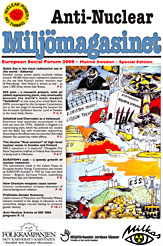Chernobyl air & flows
ECRR prediction on the global health consequences of the Chernobyl accident. Methodology of the European Committee on Radiation Risk
24-04-2011 C. Busby
chernobyl health report ECRR 2011 apr Busby
Two separate methods have been employed to calculate the global cancer yield of the Chernobyl accident. The results show between approximately 469,000 and 1.4 million incident cancers in the 10 years and 50 years following exposure. These results agree rather well with earlier estimates by Gofman (1990), Bertell (2006) and epidemiological approaches to deaths using real data by Yablokov (2011) but are much greater than those published by the World Health Organisation and the International Atomic Energy Agency or by Fairlie and Sumner 2006.
The agreement between the ECRR2003 method employed and real data on cancer from ex Soviet Union areas contaminated by Chernobyl, from weapons fallout and Sweden after Chernobyl suggests that the current approach to modelling radiation risk based on the ICRP dependence on the external exposures of the Japan A-Bomb survivor cohorts is erroneous (Lesvos Declaration 2009). The matter has significant implications for policy in the case of Fukushima.
Russian summer fires and Chernobyl fallout.
Chris Busby, PhD. 15-08-2010
“Fires in the Chernobyl area are capable of redistributing radioactive fallout particles over significant distances according to computer modeling. I employ the NOAA HYSPLIT model of the US Air Research Laboratory (1,2) to examine trajectories for particles originating at Chernobyl, Ukraine 51.26720N 30.19618E. This is an enormously powerful computer system which is freely available to anyone to use. It directly calculates the directions of airflows on the planet for any period, using a massive database of historical weather pattern information. Results show that the airflow patterns for the first two weeks of August include periods when the trajectories could have taken radioactive particles to the major capitals of the Baltic States and also to Helsinki. Other dispersion models show that same picture. There are also periods when the airflows could have taken the material south to Turkey. For example, the plot shown in Fig 1A and 1B below begins with releases at 12 hr intervals beginning at 0.00 on 7th August and forward projected for 240 hours (10 days). The NOAA HYSPLIT model program result predicts that material from Chernobyl could have arrived in Vilnius, Riga, Tallinn and Helsinki within a week…”
Download and read the whole document from:
Russian fires and Chernobyl fallout Chris Busby
An animated reconstruction of the air flows over Europe after the Chernobyl accident
“NOTHING TO REPORT” A NEW FILM directed by Alain de Halleux:
50 seconds in to the last part of the film there is a reconstruction of the air flows over Europe after the Chernobyl accident.
Part 7/7:
http://www.youtube.com/watch?v=Kq01xyqNIa4&NR=1
Film starts with Part 1/7:
http://www.youtube.com/watch?v=_YLeHNT67uI
Chernobyl Sarchofague Expedition: can the missing nuclear fuel start the second accident?
“The Chernobyl disaster was a nuclear reactor accident that occurred on 26 April 1986 at the Chernobyl Nuclear Power Plant in Ukraine (then part of the Soviet Union). It is considered to be the worst nuclear power plant disaster in history and the only level 7 event on the International Nuclear Event Scale. It resulted in a severe release of radioactivity following a massive power excursion that destroyed the reactor. Most deaths from the accident were caused by radiation poisoning.
On 26 April 1986 at 01:23 a.m. (UTC 3) reactor number four at the Chernobyl plant, near Prypiat in the Ukrainian Soviet Socialist Republic, exploded. Further explosions and the resulting fire sent a plume of highly radioactive fallout into the atmosphere and over an extensive geographical area. Four hundred times more fallout was released than had been by the atomic bombing of Hiroshima…”
http://www.youtube.com/watch?v=MHpJ7Z–QLQ&feature=grec
Svensk TV rapport of Chernobyl fr 1986:

